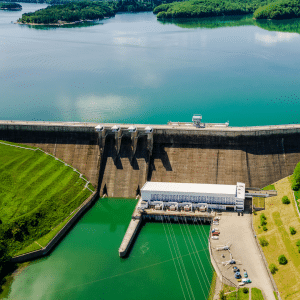The last few years have seen many pushes for electrification, especially in larger cities. What many don’t consider are the different ways electricity is produced, including the fossil fuels that are being restricted for home and business use.
 The US Energy Information Administration breaks down the numbers.
The US Energy Information Administration breaks down the numbers.
“In 2023, about 4,178 billion kilowatt-hours (kWh) of electricity were generated at utility-scale electricity generation facilities in the United States…The U.S. Energy Information Administration estimates that an additional 73.62 billion kWh of electricity generation was from small-scale solar photovoltaic systems in 2023.”
The main categories include fossil fuels, nuclear, renewables, pumped storage hydropower, and “other” sources. These are then broken down into more specific categories, starting with fossil fuels:
-
Natural Gas produces 43.1% of all electricity used in the US at 1,802 billion kWh

American Hearth – Ravenwood: 18″, 24″ & 30″ - This is enough to produce 6 quadrillion BTU of heat. To put that number into perspective, all 170,000 residents of Springfield could have their own personal fireplace running 24 hours a day for a full 18 years.
- In another comparison, running a 36,000 BTU heater for 12 hours a day costs $3.60 on natural gas and $12.60 on electricity based on Springfield City Utility rates from January 2024. In short, it’s cheaper to cut out the middleman and heat with Natural Gas in the first place.
- Coal produces 43.1% of all electricity used in the US at 675 billion kWh.
- Coal-fired plants burn the coal to produce steam, which turns turbines and generates electricity.
- Many of these plants are owned by industries and businesses that use so much power, they generate it themselves. Archer Daniels Midland, for example, own 6 coal burning plants that they use in the production of various oils, feed pellets, sugar substitutes, and even chocolate.
- Petroleum (both liquid and coke) and other gases produce a combined .7% of all electricity used in the US at 27 billion kWh.
- “Other” gases include blast furnace gas and other manufactured and waste gases derived from fossil fuels.
The next major category of electric production comes from nuclear energy. Overall, 18.6% of all electricity is generated by nuclear power plants (775 billion kWh). In Missouri, Ameren’s energy center in Callaway, MO produces 9.7% of Missouri’s electricity with their reactor alone.
Another huge source of energy production are from renewable sources that have been further developed in the past couple of decades. These newer technologies include:
- Wind produces 10.2% of all electricity used in the US at 425 billion kWh.
- This is generally from the large turbines that have been in the headlines lately but can also be produced by smaller, localized turbines in micro grids like neighborhoods or cul-de-sacs that are on the edges of a city’s standard power grid.
- Hydropower produces 5.7% of all electricity used in the US at 240 billion kWh.
- One of the original sources of renewable energy, hydropower is often obtained from dams but smaller power stations can be utilized, too. Diverting a portion of a river or even the flow of water through an irrigation ditch can also generate power which makes it one of the most widely used renewable sources in the US.
Solar produces a total of 3.9% of all electricity used in the US at 165 billion kWh.
- The majority of this energy comes from Photovoltaic Solar (aka solar panels) that can be installed in a variety of locations from residential rooftops and large parking lots to rural homesteads and even remote areas without access to power grids.
- The lesser used solar option is called Solar-Thermal power, generated from the heat of the sun. This can power a turbine for electricity generation or be used in its raw form as a heat source for things like water desalination, food processing, and even chemical and oil recovery productions. Using solar energy in this way creates a system that’s independent of other fuel sources for the same end result.
- One of the larger categories of renewable sources are Biomass fuels, sometimes created by us in the first place!
- Wood produces .8% of all electricity used in the US at 31 billion kWh in a similar process to coal powered plants, often utilizing wood waste from manufacturing. Bark, sawdust, wood chips / scrap, even paper mill waste can be converted into electricity.
- Landfill Gases produce .2% of all electricity in the US at 8 billion kWh. This is done by capturing the off gasses from manmade landfills and processing them back into methane (natural gas) for use in boilers, driers, kilns, etc., or further processed into pure, renewable methane which can be introduced into traditional natural gas transmission. These gases can also be used directly on site to create electricity for the landfill or to be sold back to local power plants.
- Municipal Solid Wates (MSW) produce .1% of all electricity used in the US at 6 billion kWh. While 61% of this waste is biomass (paper, cotton and wool, food and agricultural scrap, etc.), the remainder is non-biomass materials, namely plastics. While burning plastics is generally frowned upon, these dedicated waste-to-energy plants turn 2,000 lbs of landfill bound trash into 300-600 lbs of ash that can be used in construction projects.
- Geothermal energy produces .4% of all electricity in the US at 16 billion kWh. Simplified, the geothermal process takes naturally heated water from miles underground and directs it through turbines that convert the produced steam into energy. The cooled water is then pumped back into the ground to be reheated and the process repeats.
There are a few “other” sources of utility-scale electrical plants that total .2% of all electricity produced in the US at 10 billion kWh. These include non-biogenic solid waste, batteries, hydrogen, purchased steam, sulfur, tire-derived fuel, and other small batch plants.

Additional information and definitions from EPA.gov and Energy.gov




